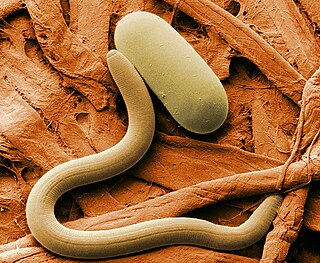
The soybean, soy bean, or soya bean is a species of legume native to East Asia, widely grown for its edible bean, which has numerous uses.

The soybean cyst nematode (SCN), Heterodera glycines, is the most devastating pest to soybean crop yields in the U.S., targeting the roots of soybean and other legume plants. When infection is severe SCNs cause stunting, yellowing, impaired canopy development, and yield loss. The symptoms caused by SCNs can go easily unrecognized by farmers—in some cases there are no warning symptoms before a loss of 40% of the yield. Due to the slight stunting and yellowing, many farmers may mistake these symptoms as environmental problems when in fact they are SCNs. Another symptom of SCNs that may affect farmers' yields is stunted roots with fewer nitrogen-fixing nodules. Due to the fact that soybean cyst nematodes can only move a few centimeters in the soil by themselves, they mostly are spread via tillage or plant transplants. This area of infection will look patchy and nonuniform making diagnosis more difficult for farmers. They can be seen in the roots of summer soybean plants if the roots are taken out very carefully and gently washed with water. The egg masses should be seen as bright white or yellow "pearls" on the roots. The later the roots are pulled the harder it will be to diagnose due to the SCNs female dying and turning a much darker color, forming a "cyst". The best way to know if a field is infected by soybean cyst nematodes is to take a soil sample to a nematologist.
Belonolaimus longicaudatus is a common parasite of grasses and other plant crops and products. It is the most destructive nematode pest of turf grass, and it also attacks a wide range of fruit, vegetable, and fiber crops such as citrus, cotton, ornamentals, and forage. The sting nematode is a migratory ectoparasite of roots. It is well established in many golf courses and presents a problem in turf management. The sting nematode is only present in very sandy soils. It cannot reproduce in heavier or clay soils.

Rotylenchulus reniformis, the reniform nematode, is a species of parasitic nematode of plants with a worldwide distribution in the tropical and subtropical regions.
Paratrichodorus minor is a species of nematode in the family Trichodoridae, the stubby-root nematodes. It occurs in tropical and subtropical regions of the world. It damages plants by feeding on the roots and it is a vector of plant viruses. It is a pest of some agricultural crops.
Pratylenchus brachyurus is a plant parasitic nematode.
Hoplolaimus columbus is a plant pathogenic nematode.
Hoplolaimus indicus is a plant pathogenic nematode affecting pearl millet.
Hoplolaimus pararobustus is a plant pathogenic nematode.
Hoplolaimus seinhorsti is a plant-pathogenic nematode affecting pigeon pea.
Quinisulcius acutus is a plant pathogenic nematode infecting soybean and sunflower.
Belonolaimus is a genus of nematodes. They are known commonly as sting nematodes. They are ectoparasites that feed on plant roots, sometimes becoming agricultural pests. They are found in the United States, Mexico, and Puerto Rico.
Hoplolaimus is a genus of nematodes known commonly as lance nematodes. They are parasites of plants, and three species are pests of agricultural crops.

Pratylenchus is a genus of nematodes known commonly as lesion nematodes. They are parasitic on plants and are responsible for root lesion disease on many taxa of host plants in temperate regions around the world. Lesion nematodes are migratory endoparasites that feed and reproduce in the root and move around, unlike the cyst or root-knot nematodes, which may stay in one place. They usually only feed on the cortex of the root. Species are distinguished primarily by the morphology of the stylets.
Tylenchorhynchus is a genus of nematodes including many species of plant parasites. The classification of stunt nematodes - those including the genus Tylenchorhynchus - is unstable; many newly discovered species within this genus are reconsidered to be actually subspecies. Stunt nematodes such as Tylenchorhynchus and the closely related genera, Anguillulina and Merlinia, include more than 250 known species. Members of these genera possess similar anatomy and may be easily mistaken for one another. Some debate has led to the classification of single species under different names in two distinct genera.

Hoplolaimidae is a family of plant pathogenic nematodes. It has two subfamilies, Hoplolaiminae and Rotylenchulinae. Typically hoplolaimids are ecto- or semi endoparasites of higher plants.
Pratylenchus alleni is a migratory endoparasitic nematode, living inside of plant roots and feeding on parenchyma cells in the root cortex. P. alleni is an obligate biotroph, meaning it must have a living host in order to survive. Due to their incredibly broad host range, Pratylenchus species fall third in total economic impact, finishing just behind cyst nematodes and root knot nematodes (Meloidogyne). In Canada, it was isolated for the first time in 2011 in a soybean field.
Hoplolaimus galeatus is a plant pathogenic nematode.

Tioxazafen [ISO] is a seed treatment nematicide developed by Monsanto to provide consistent broad-spectrum control of nematodes in corn, soy, and cotton. Its structure has a disubstituted oxadiazole skeleton, representing a new class of nematicides. Greenhouse and field trials suggest that it is at least as effective as existing commercial nematicides for the control of soybean cyst nematode, root-knot nematode, and reniform nematode.




